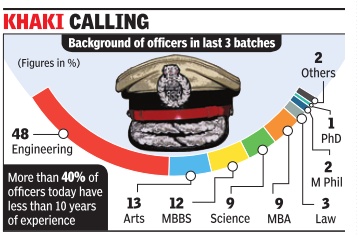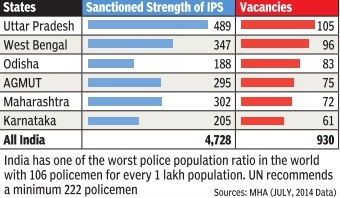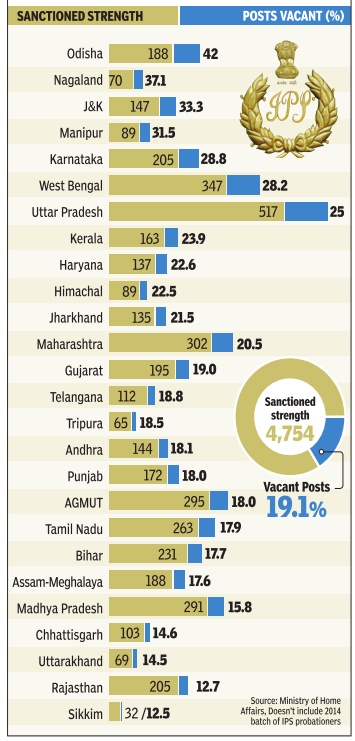Indian Police Service (IPS)
This is a collection of articles archived for the excellence of their content. |
Lateral entry
Deeptiman Tiwary, Dec 08 2014
Despite a shortage of nearly 1,000 IPS officers, the government often gives a quiet burial to the scheme of lateral entry of officers from other services into Indian Police Service. Aspirants claim that the home ministry has been dragging its feet on the issue apparently under the pressure of ‘IPS lobby’ which has been vehemently opposed to the idea, arguing it would dilute the quality of the elite service.
Owing to severe shortage of IPS officers, in 2012, the UPA government had introduced Limited Competitive Exam (LCE) through which junior-level state police, paramilitary and armed forces officers were supposed to be inducted into IPS laterally.
Exams were held under UPSC and 245 candidates were interviewed after clearing written tests. Of these, 80 were to be selected — a practice envisaged annually. The UPSC, however, has held the results back on the pretext of numerous litigations challenging the scheme.
Under the NDA government, the home ministry wrote to the law department in June to club all LCE cases and have them heard in Supreme Court to expedite the matter. Sources, however, said things have not moved in the past six months.
“This issue is too complicated with too much litigation. It is unlikely anything will happen in the case. It would be allowed to die its own death,” a senior home ministry official said.
Aspirants, however, argue that there are no legal hurdles for declaring the exam results. “Whether the government wants to continue with this scheme is its prerogative. But at least declare the results of the exam already conducted,” said one of the aspirants who too has gone to court on the issue.
2014: vacancies
Mar 24 2015
Situations vacant
Against the authorized cadre strength of 4,754 officers, the Indian Police Service (IPS) has about 20% less. A state-wise analysis of the data on sanctioned and actual strength of IPS officers shows that Odisha is understaffed by about 42%, the highest in the country. It is followed by Nagaland, Jammu & Kashmir and Manipur, each having more than 30% vacancy.In order to mitigate this shortage, the government started a `Limited Competitive Examination' to recruit IPS officers, which was held for the first time in 2012. The scheme has, however, been challenged in many court cases.
Officers with professional degrees
The Times of India, Jul 20 2015

Deeptiman Tiwary
IIT, B-school passouts are India's new `smart' cops
They are not your average cops. Some are rom an IIT and some from top-notch medical or business schools. They solve ageold policing problems with heavy use of technology and aunch innovative initiatives to prioritize ignored sectors using lessons they learned in college classrooms. Meet the new crop of IPS officers who, in a globalized India, have ignored moneyspinning careers and opted for he rigours of police service.
Thanks to the poor size of IPS batches (as low as 15 officers) between 1999 and 2003, he police service today has more than 40% of officers with less than 10 years of experience. Most of these officers come from engineering, medical or MBA backgrounds.
It is these officers who are turning out to be the force behind the Modi government's concept of smart policing.Several of their initiatives -from a specially designed software to quickly trace stolen vehicles in Karnataka to digitally connecting all police stations in a Gujarat district -have been picked up by the Bureau of Police Research and Development for inclusion in the smart policing drive. In September 2014, DCP with Bangalore police Abhishek Goyal, a 2005 batch officer and an IIT-Delhi alumnus, played a key role in launch of a social media initiative to bring about seamless communication between police and public. The city police and various officers launched their Twitter handles to communicate with the public. In less than a year's time, the total following of Bangalore police's Twitter accounts is more than 3.50 lakh. Its Facebook page has over 6 lakh followers.
Social media is used to take feedback from people and channelize police resources accordingly , be it for traffic management or crime prevention. A research on how the system made police accountable has already won two Delhi researchers an award in the US.
Goyal, who arrested suspected ISIS follower Mehdi Masrur Biswas, also launched a social media monitoring cell -using a software created to scan all social media platforms with key words related to terrorism.
Goyal's colleague in Mandya (Karnataka), Bhushan Borase, a 2009 batch IPS officer with an engineering degree from Pune University and MTech from NIT Jamshedpur, is not far behind. A vehicle database management project launched by Borase one-and-a-half years ago has helped restored 786 stolen and impounded vehicles rotting in various police stations to its rightful owners. Borase got a special software designed for this from the local engineering college. This has already bagged an award for the best e-governance initiative.
“There are vehicles stolen from the jurisdiction of one police station lying in another in the same district for years.It's because one police station does not know what the other is doing. After we brought this system, we were able to track atruck to its rightful owner after 15 years of its impounding,“ said Borase.
Ghaziabad (UP) SP Dharmendra Yadav's comprehensive programme to track missing children and restore them to their parents -called Operation Smile -has won a pat on the back from home minister Rajnath Singh, who has sought to turn it into a nationwide movement. A 2006 batch IPS officer, Yadav spent considerable energy in mapping missing children trends, training and sensitizing his constabulary and connecting various police stations for quick dissemination of information and traced 800 missing children in a matter of months.
“The details of the programme have been sent to BPRD. But this job has been more satisfying than tracking criminals,“ says Yadav.
2016: Assets of Punjab cadre officers
The Times of India, Apr 16 2016

Mohali SSP tops Punjab's IPS crorepati club
Rohan Dua The two richest legislators in Punjab according to affidavits filed in 2012 are two Congress MLAs -Kewal Dhillon with Rs 137 crore (including his son's assets) and Karan Kaur Brar with Rs 128 crore. But guess who can trump them both -senior superintendent of police (SSP) Gurpreet Singh Bhullar.
The top cop has properties worth Rs 152 crore, according to the latest property returns of IPS officers uploaded on the Union home ministry website. Bhullar who has had the longest term as SSP of Mohali has shown 16 properties that include eight residential, four agricultural and three commercial plots. His assets include a Rs 85-lakh commercial plot at the venerated Barakhamba Road in central Delhi along with a 1,500 square-yard vacant plot in Delhi's posh Sainik Farms. His most expensive asset is pegged at Rs 45 crore and mentioned as “uncultivable land“ in village Bariali in Mohali.
According to the documents, most of the properties have been inherited.Bhullar has given the source as “ancestral property flowing from grandparents“ in many cases.
The officer has had two terms as Mohali SSP, first between 2009 and 2013 and from 2015 till now. Bhullar has shown the date of acquisition for at least 12 properties as January 11, 2013.

